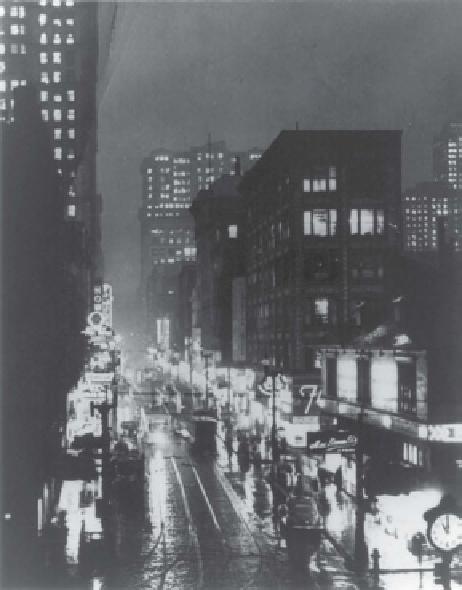Geoscience Reference
In-Depth Information
(a)
(b)
Figure 4.5.
(a) Photograph of Fifth Avenue, Pittsburgh, Pennsylvania, at 11:00 AM on November 5, 1945,
Library of Congress, Prints and Photographs Division, Washington, DC, reproduction no. LC-USZ62-76932.
(b) Smog in New York City, November 20, 1953, Library of Congress, Prints and Photographs Division,
Washington, DC, NYWT&S Collection, reproduction no. LC-USZ62-114346.
down, the pollution event continued, suggesting that the
pollution was not from the plant.
In 1945, the Los Angeles County Board of Supervi-
sors banned the emission of dense smoke and designed
an office called the Director of Air Pollution Control.
The city of Los Angeles mandated emission controls
during the same year. Also in 1945, Los Angeles County
Health Officer
H. O. Swartout
suggested that pollution
in Los Angeles originated not only from smokestacks,
butalso from locomotives, diesel trucks, backyard
incinerators, lumber mills, city dumps, and automo-
biles. In 1946, an air pollution expert from St. Louis,
Raymond R. Tucker
,washired bythe
Los Angeles
Times
to suggest methods of ameliorating air pollution
problems in Los Angeles. Tucker proposed twenty-
three methods and suggested that a countywide air
pollution agency be set up to enforce air pollution reg-
ulations (SCAQMD, 2011).
In the face of opposition from oil companies and the
Los Angeles Chamber of Commerce, the Los Angeles
County Board of Supervisors drafted legislation to be
submitted to the state of California that would allow
counties throughout the state to set up unified air pol-
lution control districts. The legislation was supported
Figure 4.6.
Panoramic view of Los Angeles, California, taken from Third and Olive Streets, December 3, 1909.
Photo by Chas. Z. Bailey, available from Library of Congress, Prints and Photographs Division, Washington, DC.




Search WWH ::

Custom Search